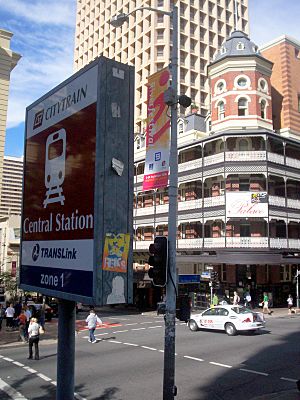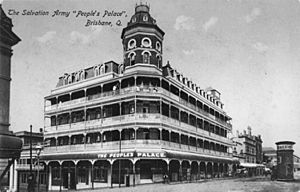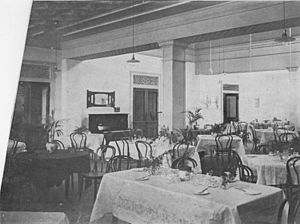People's Palace, Brisbane facts for kids
Quick facts for kids People's Palace, Brisbane |
|
|---|---|

The People's Palace, diagonally opposite Brisbane's Central railway station, 2009
|
|
| Location | 308 Edward Street, Brisbane City, City of Brisbane, Queensland, Australia |
| Design period | 1900 - 1914 (early 20th century) |
| Built | March 1910 - 1911 |
| Architect | Colonel Saunders |
| Architectural style(s) | Federation style |
| Official name: People's Palace | |
| Type | state heritage (built) |
| Designated | 21 October 1992 |
| Reference no. | 600096 |
| Significant period | 1910-1911, 1913 (fabric) |
| Significant components | elevator |
| Lua error in Module:Location_map at line 420: attempt to index field 'wikibase' (a nil value). | |
The People's Palace is a special old building in Brisbane City, Queensland, Australia. It is located at 308 Edward Street, right across from Brisbane's Central Railway Station. This building was once a unique hotel where no alcohol was allowed, known as a "temperance hotel." It was designed by Colonel Saunders and built between 1910 and 1911. Today, it is recognized as an important heritage-listed site.
Contents
History of the People's Palace
Early Ideas and Construction (1899-1911)
The idea for a People's Palace in Brisbane started in July 1899. Herbert Booth of the Salvation Army suggested it. He was inspired by a successful People's Palace in Sydney. At first, the plan was to create a safe place or shelter.
The People's Palace was built by the Salvation Army from 1910 to 1911. It was meant to be a "temperance hotel." This type of hotel offered affordable rooms for travelers. The special rule was that no alcohol, gambling, or "other evils" were allowed inside.
Lieutenant-Colonel Saunders, the Salvation Army's architect, designed the building. It was built near the Temperance Hall. The hotel had three floors with 130 rooms. It also had a basement for services and a garden on the roof. Building work began in March 1910.
Opening and Early Years (1911-1938)
Even before it was fully finished, the hotel was decorated for Coronation Day on June 22, 1911. This day celebrated the crowning of King George V.
The hotel officially opened on June 27, 1911. It was managed by Major Wilson. The People's Palace quickly became popular with travelers. Its location near Brisbane's Central Railway Station was very convenient. The building also served as the main office for the Salvation Army's Social Wing in Queensland.
In 1913, two more floors were added to the building. This made it much taller. Because of its new height, special fire safety rules were put in place. Many years later, more brick fire stairs had to be added to meet modern safety standards.
On January 20, 1938, a fire started from an electrical wire. It burned the top floor. Luckily, the damage was covered by insurance.
Later Changes and Current Use
Over the years, the building was renovated many times. Its uses and priorities changed. It operated as a temperance hotel until 1979.
After that, it was rented out as budget accommodation. It was also used as offices for the Salvation Army. More recently, it operated as a hostel for backpackers. Today, the Salvation Army has its main offices there. The building is mostly used for office space.
What the People's Palace Looks Like
The People's Palace is a large building built in the Federation style. It is mostly made of red bricks. It has painted white trimmings and fancy cast iron decorations. There is also a tall tower on the corner.
The building is shaped like a hollow rectangle. This open space in the middle lets light and air into the rooms. It has five floors plus a basement. There are also some parts built above the roof.
The building has verandahs on three levels. The fourth level has a steeply sloped roof with red tiles in a diamond pattern. You can also see dormer windows sticking out of the roof.
The corner tower is octagonal (eight-sided). It marks the main entrance. The tower has a bell-shaped roof with small dormers on each side. Next to the tower is a brick lift tower.
The verandahs have decorative cast iron balustrades (railings) and friezes (decorative bands). They also have timber posts and handrails. The round and semi-circular windows on the tower have cream-colored trimmings. These stand out against the red brick.
Inside, the rectangular courtyard has been divided into two. A modern brick fire stair was added there. A hipped roof with a clerestory (upper windows) is still above the basement dining room. This area is now used as office space. However, its original entry doors are still there.
Many parts of the building still have their original Pressed metal ceilings. The upper floors have not been changed much. But the lower floors have new walls. The original lift is still there next to the entry foyer. It has sliding doors and timber panels.
The building's unique look comes from its many decorative cast iron features. It also stands out because of the contrast between the cream-colored render and the red brick on the tower. Since it is on a hill at a busy intersection, it is one of Brisbane's most recognizable buildings.
Why the People's Palace is a Heritage Site
The People's Palace was added to the Queensland Heritage Register on October 21, 1992. This means it is considered very important to Queensland's history and culture.
Rare and Unique History
The People's Palace is special because it is a rare example of a building made specifically as a temperance hotel. This shows a unique part of Queensland's history.
Important Architectural Style
The building is a great example of a Federation style building. It shows the main features of this type of architecture.
Beautiful Design and Landmark Status
The People's Palace has a beautiful design that people in the community value. It is a fine example of a Federation-style building with its brick and render. The corner entry tower and the decorative cast-iron work on the verandahs are especially admired.
It is also a very noticeable landmark. Its corner tower is one of several important towers along Ann Street.
Connection to the Salvation Army
The building has a special connection to the work of the Salvation Army. The Salvation Army has used this building since 1911. This organization has been very important in Queensland's history.



